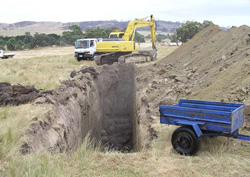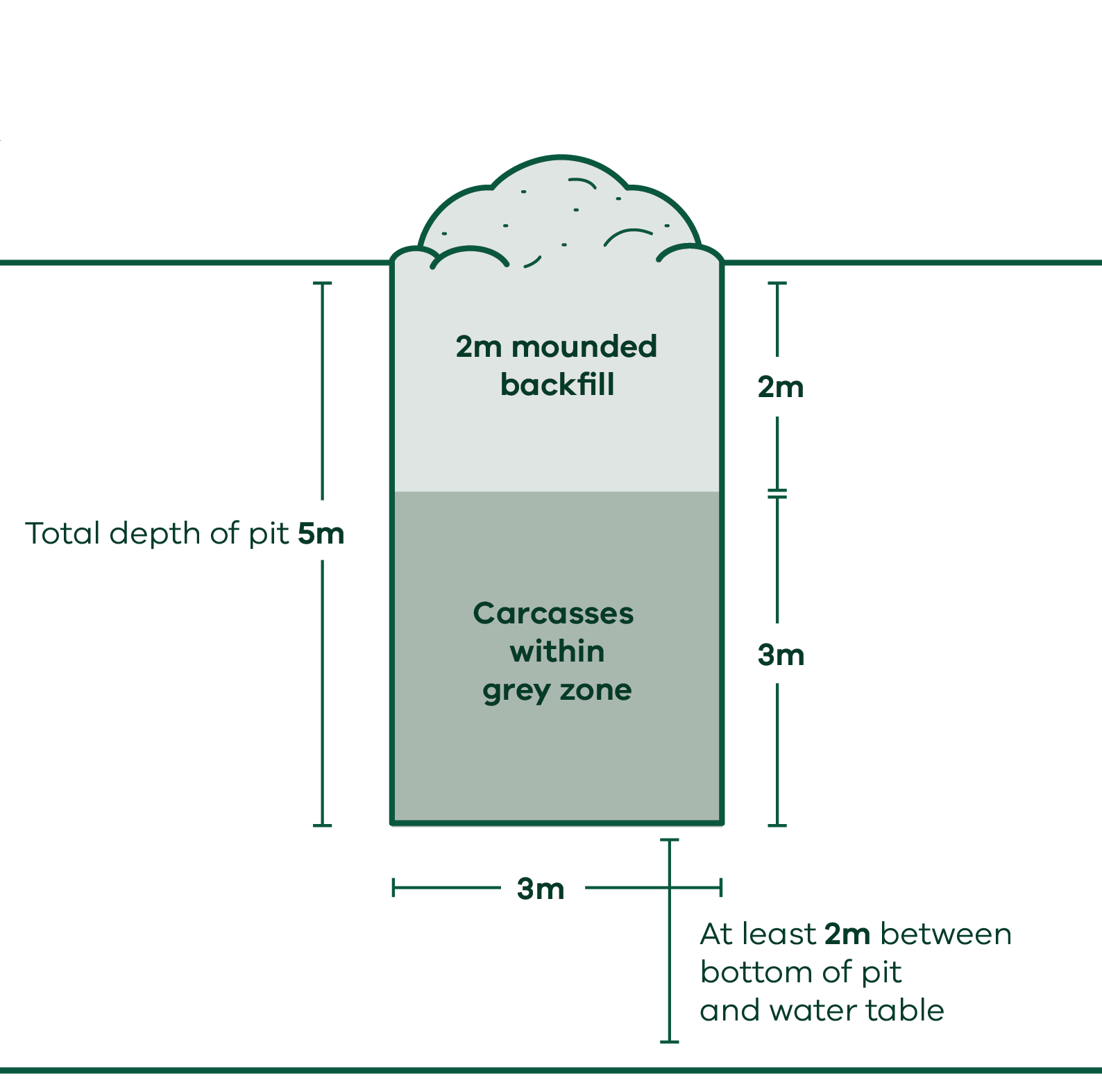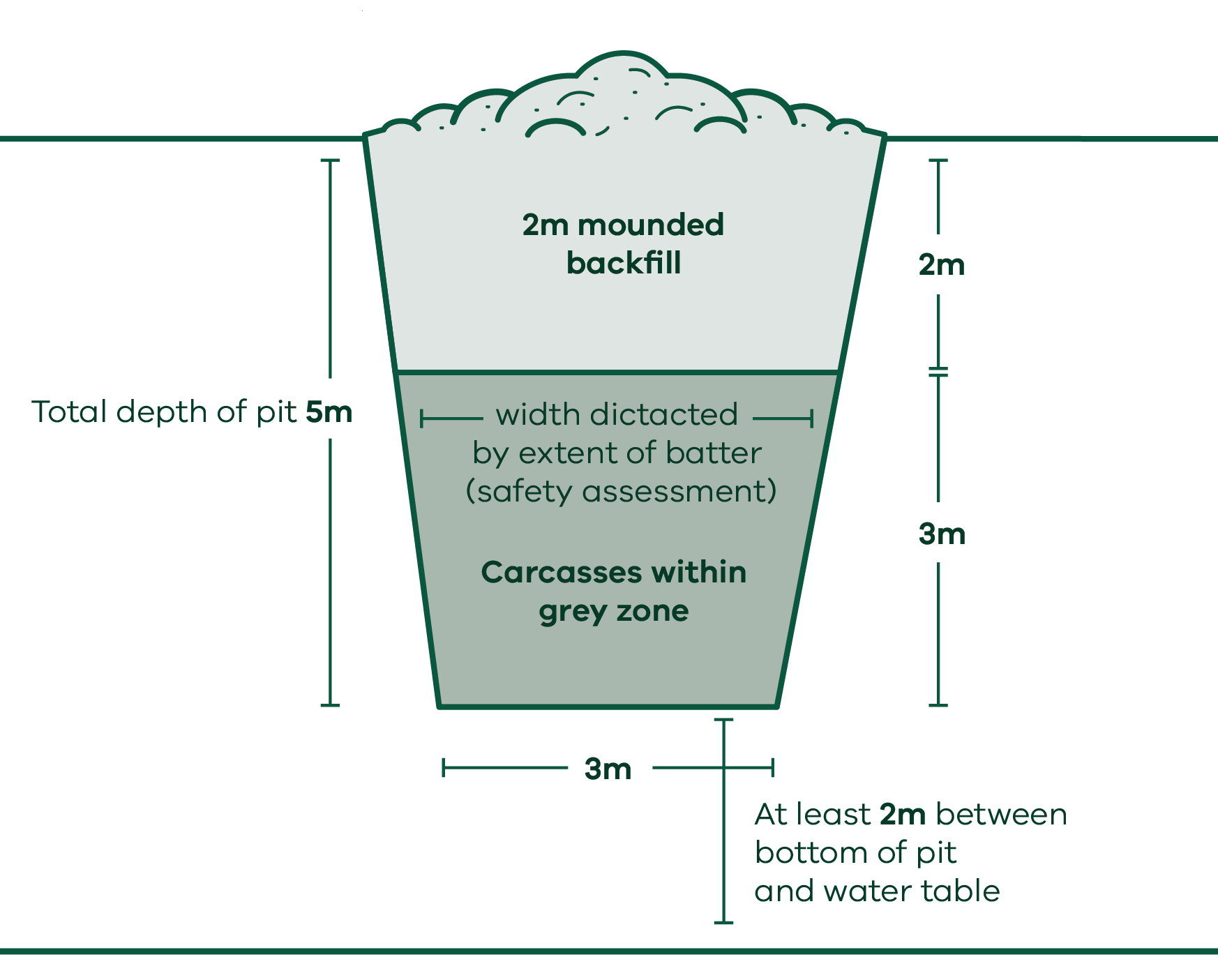Disposing of carcasses after bushfire, flood or drought
A bushfire, flood and drought can result in animal carcasses requiring disposal.
There are several options outlined below for livestock producers for carcass disposal
Please note this information does not include emergency animal diseases (EAD) carcass disposal.
Disposal responsibilities
The land manager is responsible for carcass disposal.
Agriculture Victoria provides advice on disposal needs regarding deceased livestock.
On-farm and off-farm options exist for the disposal of animal carcasses, including, knackeries and rendering facilities, licensed landfills and on-farm burial..
The Environment Protection Authority provides emergency approvals in line with the Environment Protection Act 2017.
EPA publications
For more information on carcass disposal after bushfires see the EPA fact sheet Disposal of bushfire waste.
For managing routine livestock mortalities see Farm waste management.
Disposal options
On-farm burial is the traditional method of carcass disposal following bushfire, flood or drought events. While it is quick, effective and relatively cheaper than other options, other options need to be considered before initiating a burial program, particularly if it is significant.
Knackeries
Knackeries provide an efficient means of disposing of dead, unsaleable or suffering livestock. Carcasses can be processed for:
- fresh meat
- saleable hide
- offal.
For commercial reasons, knackeries prefer to process larger animals such as cattle and horses. Knackeries may pick up sheep carcasses, but this is usually as a service and generally only in small numbers.
It is unlikely that knackeries will accept moderate to severely burnt livestock.
Rendering
Rendering is an effective method of converting animal carcasses into saleable products such as meat and bone meal, and tallow. Rendering plants are located throughout Victoria and some have the capacity to process large volumes of animal material.
The practicality of using rendering as a disposal method may be limited by:
- rendering companies' willingness to receive product
- suitability of product (such as degree of burns, decomposition, emaciated stock, amount of wool)
- plant capacity
- cost of transport.
Licensed landfill
Disposing of carcasses to licensed landfill is an acceptable and effective option for agricultural emergencies.
The advantage of landfill is that it may already be licensed to accept animal materials (putrescible waste) and generally has the existing infrastructure to manage long-term containment issues (such as leachate, gas, security).
Another advantage of landfill is that many sites are owned by local government and may already be identified as potential disposal sites under Municipal Emergency Management Plans.
On-farm burial
When planning for on-farm burial there are many factors that must be considered. These include:
- the environment
- statutory controls
- logistics
- safety.
To reduce any impact on the environment, a burial site should be located:
- at least 200 metres from any groundwater supply (stock and domestic bore)
- at least 2 metres above the water table level (measured from the bottom of the pit)
- at least 200 metres from any surface water (creek, river, lake or spring), excluding dams that are not seeping into groundwater or flowing offsite
- away from surface water drainage features, low points or areas at risk of erosion
- on clay soil of low permeability and good stability
- away from underground and above-ground infrastructure (such as powerlines, telephone and fibre optic lines, gas lines, waterpipes or sewerage)
- above the one in 100-year flood level
- at least 200 metres from another burial area
- on elevated land but with a slope of less than 5% (preferably less than 2%)
- away from conservation areas and areas of cultural sensitivity
- at least 200 metres from the boundary of neighbouring privately owned land
- at least 300 metres from any sensitive use (such as a neighbouring house)
- out of view of the public (by either being far away from public areas or by screening).
Operators should also:
- cover carcasses with at least two metres of soil
- slightly mound pits after backfilling to allow for subsidence and promote runoff rather than infiltration
- where necessary, excavate cut-off drains upslope of the burial pits to direct surface run-off away from the pits
- where possible, plan destruction activities close to burial site
- have good, safe access to site for machinery.
Other important factors that must be considered are:
- monitoring programs (if required by EPA)
- leachate and gas management (if required by EPA)
- use of synthetic liners in pits (if required by EPA)
- native flora and fauna planning controls, heritage overlays, native title and covenants.
Final site selection usually involves the agreed best outcome after consultation with relevant agencies and a risk assessment of all factors.
Burial site assessments
Ideally, a potential burial site should be assessed for suitability by an EPA representative. In a bushfire response where there are many on-farm sites, an on-site assessment may not be practical and so a proposed burial pit location, using the burial criteria listed above and drawn on a farm map, can assist EPA to advise you on the suitability of the burial site’s location. The location of each disposal site should be recorded for future reference using a global positioning system (GPS).
The Navigating Farm Development Tool can assist you to determine a suitable burial pit location in line with the burial criteria. Although designed for an emergency animal disease event, the burial criteria are the same.
Pit construction
The typical method of digging a pit is to construct a deep, narrow, vertically sided pit (trench burial), but this will be dictated by the soil stability.
Where soil stability is of concern, a battered design should be used to enhance operator safety. WorkSafe Victoria can provide information on safety precautions for emergency trenching operations.
The preferred equipment for constructing this type of pit is an excavator. During construction, topsoil should be separated from subsoil for later return to the top during pit closure. Excavated material should be stored along one side or at the ends of the pit, depending on the operation. Surplus soil should be heaped as overfill.
Pit dimensions
In designing dimensions of a pit, consideration should be given to the method used to fill the pit with carcasses. Typically, carcasses will be unloaded (out of tip trucks) and then pushed into the pit (loader, bulldozer or excavator) from one of the long sides.
It is critical that a safe operating zone is established as part of a documented work procedure. Excavators can be a good option to fill pits with carcasses, especially where soil stability is a potential issue.
When using on-farm trench burial, the following dimensions can be used as a guide:
- Depth – 4 to 5 metres (depending on reach of machinery, soil stability and depth to water table). Base of pit to be at least 2 metres above water table level
- Width – not greater than 3 metres wide (to allow for even spread of carcasses in pit)
- Length – depends on number and size and of carcasses to be buried (volume)
- Backfill – 2 metres of backfill to be placed over carcasses
- Volume – carcass volume will vary according to number and size of animals
Volume requirements
Previous drought experience has shown that approximately 10 adult sheep in poor condition and with limited wool will take up one cubic metre of pit space. (North-East Region Flock Reduction Scheme)
As a guide, allow 1.5 cubic metres of pit space for one adult beast or 5 adult sheep in good condition. (AUSVETPLAN Disposal Manual, 2015)
Slashing
The slashing of the abdomens of carcasses before burial (to reduce the build-up of gas) is not recommended for sheep or other small animals, or badly decomposed cattle.
For freshly dead cattle, a risk assessment should be conducted to determine if the benefits of slashing outweigh the safety risks to the operator. Machinery may be used to puncture the abdomens of cattle to reduce manual handling risks.
Example diagrams of burial pits


Personal (worker) safety
The burial of animal carcasses in trenches deep enough to control health risks can potentially create a risk to workers of trench collapse.
Safety of onsite staff and contractors must always be considered:
- Minimum of 2 people should always be at the pit site.
- Maintain a safe working distance from pit edge.
- No persons should be allowed to enter the pit.
- Rescue items such as ropes should be available in case of collapsing walls or a person falling into the pit.
- Appropriate personal protective equipment (PPE) (such as gloves, overalls and dust masks) should be used.
- Assess every manual handling task. Use mechanical aids where possible.
- All persons should be properly briefed on the site operations and the safety plan.
Personal (worker) protection
Disposing of large numbers of animal carcasses can potentially have effects on human health. For information on health concerns relating to bushfires refer to Bushfires and public health on the Department of Health website.
Generally:
- handle carcasses as little as possible
- clean and cover cuts or broken skin with waterproof dressings before commencing disposal activities
- wash hands with soap and clean water after contact with animals and removing of PPE.
Personal protective equipment (PPE)
Take reasonable efforts to protect yourself from the inhalation of dust or other aerosols particularly where Q fever infection may be a risk. Wearing a P2 Mask (Particulate respirator) should be considered and assessed on a case-by-case basis.
Mandatory items:
- gloves
- leather or rubber boots
- clothes that cover exposed skin (long sleeves and trousers)
- eye protection.
In some instances, worker illness and injury or accident events may be classified as a notifiable incident to the safety regulator WorkSafe Victoria.
Scale of response
The scale of the incident response will have a major impact on the available methods of disposal.
In a small response, activities may be confined to on-farm burial. In a larger response, communal burial sites may be used for animals from several affected properties.
Communal burial sites may be located on private land or may be on publicly owned land such as:
- licensed landfills
- unlicensed landfills.
As a response escalates the burial methods may change from trench burial to mass burial, where pit dimensions are significantly modified. Mass burial usually requires significant site assessment and enhanced environmental controls.
In some instances, an approval to discharge waste may need to be issued by EPA (Section 157 of the Environment Protection Act 2017).
More information
For more information contact the Customer Contact Centre on 136 186.